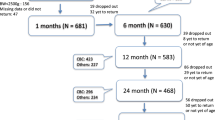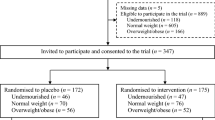Abstract
Objective:
To evaluate the effect of combined iron–zinc supplementation on micronutrient status, growth and morbidity.
Design:
Randomized, double-masked, placebo-controlled supplementation trial.
Setting:
Rural district of Que Vo, in the Red River Delta in Vietnam.
Subjects:
A total of 915 breast-fed infants aged 4–7 months were included and 784 completed the study.
Interventions:
The Fe-group received daily and for a 6-month period 10 mg of iron, the Zn-group 10 mg zinc, the Fe–Zn group 10 mg iron+10 mg zinc and the placebo group a placebo. Hemoglobin (Hb), serum ferritin (SF) and zinc (SZn), and anthropometry were measured before and at the end of the intervention. Morbidity was recorded daily.
Results:
Changes of Hb and SF were higher in both Fe and Fe+Zn groups (respectively 22.6 and 20.6 g/l for Hb; 36.0 and 24.8 μg/l for SF) compared to Zn and placebo groups (Hb: 6.4 and 9.8 g/l; SF: −18.2 and −16.9 μg/l, P<0.0001). SZn increased more in Zn group (10.3 μmol/l) than in Fe+Zn group (8.0 μmol/l, P=0.03) and more in these groups compared to Fe and placebo groups (1.6 and 1.2 μmol/l, P<0.0001). Weight gain was higher in the Zn group. No significant effects of supplementations on growth in length or morbidity.
Conclusions:
Combined iron–zinc supplementation had a positive effect on iron and zinc status in infants. However, the positive effect of zinc alone on SZn and weight would indicate a negative interaction of iron when added to zinc supplements.
Sponsorship:
UNICEF New York.
This is a preview of subscription content, access via your institution
Access options
Subscribe to this journal
Receive 12 print issues and online access
$259.00 per year
only $21.58 per issue
Buy this article
- Purchase on Springer Link
- Instant access to full article PDF
Prices may be subject to local taxes which are calculated during checkout



Similar content being viewed by others

References
Allen LH, Rosado JL, Casterline JE, Lopez P, Munoz E, Garcia OP et al. (2000). Lack of hemoglobin response to iron supplementation in anemic Mexican preschoolers with multiple micronutrient deficiencies. Am J Clin Nutr 71, 1485–1494.
Beard J, Stoltzfus R (2001). Iron-deficiency anemia: reexamining of the nature and magnitude of the public health problem. Foreword. J Nutr 131, 563S.
Berger J, Aguayo VM, Tellez W, Lujan C, Traissac P, San Miguel JL (1997). Weekly iron supplementation is as effective as 5 day per week iron supplementation in Bolivian school children living at high altitude. Eur J Clin Nutr 51, 381–386.
Berger J, Dyck JL, Galan P, Aplogan A, Schneider D, Traissac P et al. (2000). Effect of daily iron supplementation on iron status, cell-mediated immunity, and incidence of infections in 6–36 month old Togolese children. Eur J Clin Nutr 54, 29–35.
Bhutta ZA, Black RE, Brown KH, Gardner JM, Gore S, Hidayat A et al. (1999). Prevention of diarrhea and pneumonia by zinc supplementation in children in developing countries: pooled analysis of randomized controlled trials. Zinc Investigators’ Collaborative Group. J Pediatr 135, 689–697.
Bloem MW, Wedel M, Van Agtmaal EJ, Speek AJ, Saowakontha S, Schreurs WHP (1990). Vitamin A intervention: short-term effects of a single, oral, massive dose on iron metabolism. Am J Clin Nutr 51, 76–79.
Brown K (1998). Effect of infections on plasma zinc concentration and implications for zinc status assessment in low-income countries. Am J Clin Nutr 68, 425S–429S.
Brown KH, Peerson JM, Rivera J, Allen LH (2002). Effect of supplemental zinc on the growth and serum zinc concentrations of prepubertal children: a meta-analysis of randomized controlled trials. Am J Clin Nutr 75, 1062–1071.
Cavan KR, Gibson RS, Grazioso CF, Isalgue AM, Ruz M (1993). Growth and body composition of periurban Guatemalan children in relation to zinc status: a cross-sectional study. Am J Clin Nutr 57, 334–343.
Dallman PR, Siimes M, Stekel A (1980). Iron deficiency in infancy and childhood (1980). Am J Clin Nutr 33, 86–118.
Dijkhuizen MA, Wieringa FT, West CE, Martuti S, Muhilal (2001). Effects of iron and zinc supplementation in Indonesian infants on micronutrient status and growth. J Nutr 131, 2860–2865.
Fairweather-Tait SJ (1992). Iron deficiency in infancy: easy to prevent – or is it ? Eur J Clin Nutr 46 (Suppl 4), S9–S14.
Flowers CA, Kuizon M, Beard JL, Skikne BS, Covell AM, Cook JD (1986). A serum ferritin assay for prevalence studies of iron deficiency. Am J Hematol 23, 141–151.
Friis H, Ndhlovu P, Mduluza T, Kaondera K, Sandstrom B, Michaelsen KF et al. (1997). The impact of zinc supplementation on growth and body composition: a randomized, controlled trial among rural Zimbabwean schoolchildren. Eur J Clin Nutr 51, 38–45.
Gera T, Sachdev HPS (2002). Effect of iron supplementation on incidence of infectious illness in children: systematic review. BMJ 325, 1142–1152.
Golden MHN, Golden BE (1981). Effect of zinc supplementation on the dietary intake, rate of weight gain, and energy cost of tissue deposition in children recovering from severe malnutrition. Am J Clin Nutr 34, 900–908.
Hop LT, Berger J (2005). Multiple micronutrient supplementation improves anemia, micronutrient status and growth of Vietnamese infants: double blind, randomized, placebo-controlled trial. J Nutr 135, 660S–665S.
Hotz C, Brown KH (2001). Identifying populations at risk of zinc deficiency: the use of supplementation trials. Nutr Rev 59, 80–84.
Hotz C, Peerson JM, Brown KH (2003). Suggested lower cutoffs of serum zinc concentrations for assessing zinc status: reanalysis of the second National Health and Nutrition Examination Survey data (1976–1980). Am J Clin Nutr 78, 756–764.
Idjradinata P, Watkins WE, Pollitt E (1994). Adverse effect of iron supplementation on weight gain of iron-replete young children. T Lancet 343, 1252–1254.
International Nutritional Anemia Consultative Group (1985). Measurements of iron status. The Nutrition Foundation, Inc: Washington, USA. A report of the International Anemia Consultative Group, 1–78.
Khoi HH, Khan NC, Mai LB, Tuyen LD (2003). 2000 General Nutrition Survey. Medical Publishing House: pp 1–168.
Kolsteren P, Rahman SR, Hilderbrand K, Diniz A (1999). Treatment for iron deficiency anaemia with a combined supplementation of iron, vitamin A and zinc in women of Dinajpur, Bangladesh. Eur J Clin Nutr 53, 102–106.
Lind T, Lonnerdal B, Stenlund H, Gamayanti IL, Ismail D, Seswandhana R et al. (2004). A community-based randomized controlled trial on iron and zinc supplementation in Indonesian infants: effects on growth and development. Am J Clin Nut 80, 729–736.
Lind T, Lonnerdal B, Stenlund H, Ismail D, Seswandhana R, Ekstrom E-C et al. (2003). A community-based randomized controlled trial of iron and zinc supplementation in Indonesian infants: interactions between iron and zinc. Am J Clin Nutr 77, 883–890.
Lira P, Ashworth A, Morris S (1998). Effect of zinc supplementation on the morbidity, immune function, and growth of low-birth-weight, full-term infants in northeast Brazil. Am J Clin Nutr 68, 418S–424S.
Liu XN, Liu PY (1996). The effectiveness of weekly iron supplementation regimen in improving the iron status of Chinese children and pregnant women. Biomed Environ Sci 9, 341–347.
Lozoff B, Brittenham GM, Wolf AW, McClish DK, Kuhner PM, Jimenez E et al. (1987). Iron deficiency anemia and iron therapy effects on infant developmental test performance. Pediatrics 79, 981–995.
Mejia LA, Chew F (1988). Hematological effect of supplementing anemic children with vitamin A alone and in combination with iron. Am J Clin Nutr 48, 595–600.
Munoz EC, Rosado JL, Lopez P, Furr HC, Allen LH (2000). Iron and zinc supplementation improves indicators of vitamin A status of Mexican preschoolers. Am J Clin Nutr 71, 789–794.
NIN/UNICEF/CDC/PAMM (1995). Report of the National Anemia and Nutrition Risk factor survey, Vietnam 1995 National Institute of Nutrition, Vietnam, UNICEF–Vietnam, Centers for Disease Control, USA; Program Against Micronutrient Malnutrition. pp 1–50.
Ninh NX, Berger J, Quyen DT, Khan NC, Traissac P, Khoi HH (2002). Efficacité de la supplémentation en fer quotidienne et hebdomadaire pour le contrôle de l’anémie chez le nourrisson en milieu rural au Viêt Nam. Cahiers Santé 12, 31–37.
Ninh NX, Thissen J-P, Collette L, Gerard G, Khoi HH, Ketelslegers J-M (1996). Zinc supplementation increases growth and circulating insulin-like growth factors I (IGF-I) in growth-retarded Vietnamese children. Am J Clin Nutr 63, 514–519.
Punnonen K, Irjala K, Rajamaki A (1997). Serum transferrin receptor and its ratio to serum ferritin in the diagnosis of iron deficiency. Blood 89, 1052–1057.
Rivera JA, Ruel MT, Santizo MC, Lonnerdal B, Brown KH (1998). Zinc supplementation improves the growth of stunted rural Guatemalan infants. J Nutr 128, 556–562.
Rosado JL, Lopez P, Munoz E, Martinez H, Allen LH (1997). Zinc supplementation reduced morbidity, but neither zinc nor iron supplementation affected growth or body composition of Mexican preschoolers. Am J Clin Nutr 65, 13–19.
Sandstead H, Penland J, Alcock N, Dayal HH, Chen XC, Li JS et al. (1998). Effects of repletion with zinc and other micronutrients on neuropsychologic performance and growth of Chinese children. Am J Clin Nutr 68, 470S–475S.
Smuts CM, Lombard CJ, Benadé AJS, Dhansay MA, Berger J, Hop LT et al. (2005). Efficacy of a foodlet-based multiple micronutrient supplement for preventing growth faltering, anemia, and micronutrient deficiency of infants: the four country IRIS trial pooled data analysis. International Research on Infant Supplementation (IRIS) study group. J Nutr 135, 631S–638S.
Solomons NW, Ruz M (1997). Zinc and iron interaction: concepts and perspectives in the developing world. Nutr Res 17, 177–185.
Thu BD, Schultink W, Dillon D, Gross R, Leswara ND, Khoi HH (1999). Effect of daily and weekly micronutrient supplementation on micronutrient deficiencies and growth in young Vietnamese children. Am J Clin Nutr 69, 80–86.
Whittaker P (1998). Iron and zinc interactions in humans. Am J Clin Nutr 68, 442S–446S.
Acknowledgements
We are grateful to all the infants and their parents who participated in this study and to field workers and other personnel at the National Institute of Nutrition (Hanoi) for their collaboration. The technical assistance of V Bianco of IRD during the statistical evaluation is gratefully acknowledged. The financial contribution by UNICEF and the constant support of M Tolvanen from UNICEF to this study are greatly acknowledged.
Author information
Authors and Affiliations
Corresponding author
Additional information
Guarantor: J Berger.
Contributors: JB and NXN were the principal investigators of the study. They were responsible for the design and the implementation of the study. JB was responsible for data management and analysis. JB and NXN were responsible for the preparation of the manuscript. NXN was responsible for day-to-day supervision of the field staff and development of the study. NCK, HHK and NQT contributed to the development of the study protocol. NVN and DKL were responsible for the analysis of hemoglobin, plasma ferritin and zinc analysis under supervision of NXN and JB.
Rights and permissions
About this article
Cite this article
Berger, J., Ninh, N., Khan, N. et al. Efficacy of combined iron and zinc supplementation on micronutrient status and growth in Vietnamese infants. Eur J Clin Nutr 60, 443–454 (2006). https://doi.org/10.1038/sj.ejcn.1602336
Received:
Revised:
Accepted:
Published:
Issue Date:
DOI: https://doi.org/10.1038/sj.ejcn.1602336
Keywords
This article is cited by
-
Zinc Supplementation for Promoting Growth in Children Under 5 years of age in Low- and Middle-income Countries: A Systematic Review
Indian Pediatrics (2019)
-
Hair Zinc: an Index for Zinc Status in Under-Five Children from Low-Income Communities in Kanam Area of North-Central Nigeria
Biological Trace Element Research (2018)
-
The effect of a micronutrient powder home fortification program on anemia and cognitive outcomes among young children in rural China: a cluster randomized trial
BMC Public Health (2017)
-
Effect of preventive zinc supplementation on linear growth in children under 5 years of age in developing countries: a meta-analysis of studies for input to the lives saved tool
BMC Public Health (2011)
-
The time of day and the interval since previous meal are associated with plasma zinc concentrations and affect estimated risk of zinc deficiency in young children in Peru and Ecuador
European Journal of Clinical Nutrition (2011)


